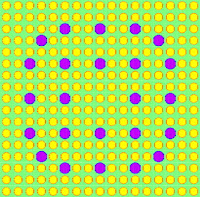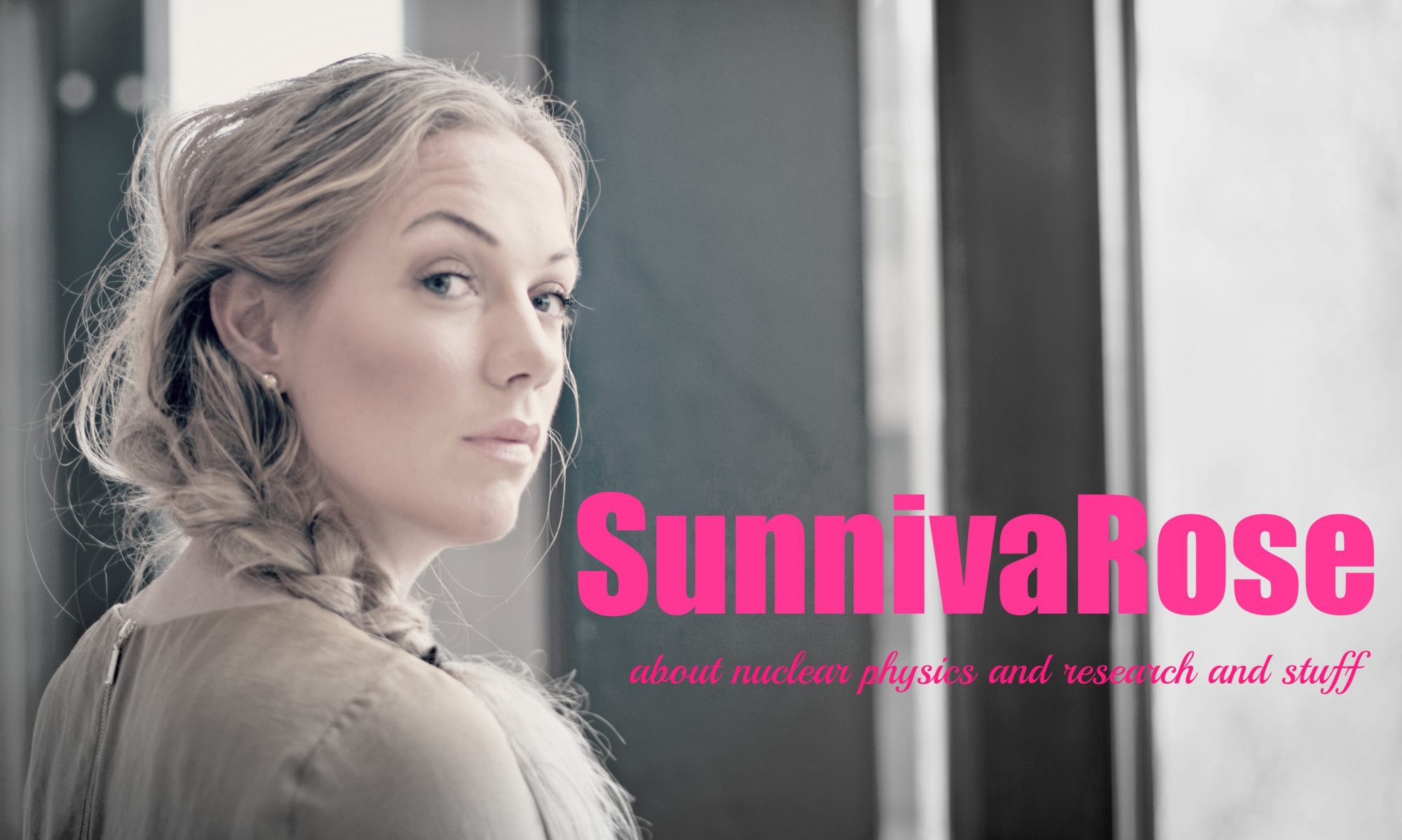Tenkte dere kanskje kunne være litt interessert (ihvertfall noen av dere?) i hva jeg egentlig
holder på med på Blindern;) Så special for you: om en mulighet med thorium i kjernekraftverk - på en måte slik at vi ikke trenger å utvikle en ny reaktor (som koster MYE, og er flere tiår inn i fremtiden, dessverre).
Bare for å understreke: jeg mener ikke at vi ikke skal forske på å utvikle ny reaktorteknologi, altså, men jeg syns det er spennende å se hva vi kan få til per i dag, med den teknologi som vi faktisk har. På samme måte som at jeg ikke mener vi ikke skal forske på solceller - men solcellene er heller ikke gode nok i dag til å konkurrere med den energien vi kan produsere med kjernekraft. Ja, takk! Begge deler!
Enjoy!
The multi-recycling of innovative uranium/thorium oxide fuels for use in the European Pressurized water Reactor (EPR) has been investigated. If increasing quantities of 238U, the fertile isotope in standard UO2 fuel, are replaced by 232Th, then a greater yield of new fissile material (233U) is produced during the cycle than would otherwise be the case. This leads to economies of natural uranium of around 45% if the uranium in the spent fuel is multi-recycled. In addition we show that waste radio-toxicities and decay heats are up to a factor of 20 lower after 103 years. Two innovative fuel types named S90 and S20, ThO2 mixed with 90% and 20% enriched UO2 respectively, are compared as an alternative to standard uranium oxide (UOX) and uranium/plutonium mixed oxide (MOX) fuels at the longest EPR fuel discharge burn-ups of 65 GWd/t. Fissile and waste inventories are examined, waste radio-toxicities and decay heats are extracted.
1 Introduction
Thorium is a fertile material that can easily be transformed into fissile 233U by thermal neutron capture. 233U does not exist in nature but is an excellent fissile material which has a higher η (∼2.3), the number of neutrons emitted per neutron absorbed, than the analogous fissile plutonium isotopes 239, 241Pu (∼1.7, ∼2.1) from the U/Pu cycle. This implies that the yield of new fissile material in fuels containing fertile 232Th will always be greater than for those containing fertile 238U, assuming a thermal neutron spectrum. Furthermore, the neutron capture/fission ratio of 233U (∼0.11) is lower than that of 239Pu (∼0.55) and five successive neutron captures on fertile 232Th are required to produce a trans-uranium element (TRU), while only one is necessary for fertile 238U. Therefore, production rates for the TRU’s, the major long-lived nuclear waste components will be much lower if 238U is replaced with 232Th.
We focus here on the EPR reactor and examine the consequences of removing significant quantities of fertile 238U from conventional UOX fuel and replacing it with fertile 232Th. This is achieved by blending thorium with uranium enriched to higher content of fissile 235U than the typical 4% needed for PWRs. We examine two new types of innovative fuel for the EPR, S20, a mixture of 20% enriched UO2 and ThO2, and S90, a mixture of 90% enriched UO2 and ThO2, and compare with conventional UOX fuel and MOX fuel fabricated from the plutonium recovered in spent UOX reprocessing.
The EPR is a Generation III + PWR concept, which is an evolutionary design rather than revolutionary and based on proven pressurized water technology - currently the most widely used worldwide.
In theory, light water reactors (LWRs) with a thermal neutron spectrum using 233U/232Th fuels can breed self-sustaining amounts of new fissile material since 2.3 neutrons are available per neutron absorbed, and indeed breeding was proven in the Shippingport Light Water Breeder Reactor [1]. However, for a light water power reactor with realistically long cycle lengths there will be significant losses of neutrons to captures on the hydrogen in the water coolant, the fission products, the control poisons, the 233Pa intermediate thorium cycle nucleus and the structural materials, and thus the breeding ratio will be less than unity and breeding will be impossible. For breeding ratios of less than one, the thorium cycle will not be self-sustaining and the reactor will be dependent on a supply of some fissile material from the uranium cycle – either new fissile 235U or 239,241Pu.
Concepts
dedicated exclusively as thorium cycle breeder reactors have been suggested, e.g. the Thorium Molten Salt Reactor [2] and the use of thorium in sodium critical reactors [3], or in subcritical accelerator driven systems [4-6]. However, these technologies are very different from current power reactor designs and cannot use existing cycle infrastructure. A large amount of research and development is needed for these systems and thus commercial power production could be decades into the future. Since LWRs comprise around 80% of the world fleet of operating plants, the fastest way to explore the potential of thorium is through the use of innovative solid fuels in the existing infrastructure of operating plants.
The once through cycle (OTC) is the cheapest fuel cycle in the short term. However, the potential energy content of the residual fissile and fertile isotopes is lost, and the OTC also gives the largest possible volume of high-level waste. The potential energy content of the spent fuel provides an incentive to recover the fissile isotopes. Fuel recycling also reduces the mass of high-level waste and the time of high radio-toxicity of waste, thus reducing the requirements for both the number of repositories and the duration of geological storage. The goal of the present work is to examine thoriated fuels as an alternative to present MOX recycled fuels that should provide greater economy of uranium resources and lower waste inventories.
2 EPR simulations with the MURE code
An EPR assembly based on a 17 × 17 lattice was modeled using MURE (MCNP Utilities for Reactor Evolution), based on the Monte-Carlo neutron transport code MCNP5 [7]. MURE is a precision research code that has been developed jointly at the Institut de Physique Nucléaire d’Orsay (IPNO) and the Laboratoire de Physique Subatomique et Cosmologie (LPSC) of Grenoble [8]. MURE performs calculations of the time-evolution of reactor fuels with full 3D geometry. Consecutive MCNP calculations are performed to determine reaction rates and deduce core material evolution over time at a constant reactor power by solving the set of coupled differential equations for the production and destruction of isotopes.
 |
|
Fig. 1. Cross section of the simulated EPR assembly
|
The EPR simulations presented in here are based on a single, homogeneous, core-equivalent assembly placed as an infinite lattice in the radial direction, but with axial leaks permitted. This assembly consists of 265 fuel pins of 0.475 cm outer radius with a M5 Zircaloy cladding of 0.57 mm thickness, and 24 guide tubes of radius 0.616 cm for insertion of control rods (see Figure 1). The fuel pins have homogeneous mixtures of UO2 and ThO2.
For any proposed innovative fuel types to be economically viable they must be able to compete with UOX fuels at the longest burn-ups, therefore only realistically long discharge burn-ups were studied. The EPR is designed to achieve long burn-ups of 70 GWd/t, which is longer than current PWR’s (typically 50–55 GWd/t). Therefore, for the present studies discharge burn-ups of 65 GWd/t were simulated.
To compensate the excess reactivity present after reloading points in the cycle, sufficient quantities of boric acid were added to the water coolant in the assembly. A fuel manag
ement scheme based on the use of three batches per cycle was used as is standard for operation of current PWR’s. Simulation of the full cycle required around 70 consecutive MCNP calculations. The burn-up step lengths were chosen as 5 h, 21 h, 3 days, 9 days and then repeated steps of 28 days to allow more frequent calculation of the fuel composition after startup where isotope concentrations are changing the most rapidly.
Initial uranium/thorium molar proportions for the fuels were found from fits to proportion vs maximum cycle length curves obtained from several fuel burn-up calculations at varying initial concentrations. The plutonium vector of the MOX fuel is taken to be the plutonium vector at discharge from the UOX fuel (containing 67% fissile material) minus the losses of 241Pu, some of which decays to 241Am during the 5 year cooling period.
The UOX, S20 and S90 fuel types contain similar quantities of initial fissile 235U, although the thorium content varies considerably. The S20 and S90 fuels initially require more separative work units (SWU) and slightly more natural uranium, but this initial investment is repaid after the fuel is reprocessed, where the spent fuel will have a much higher recoverable fissile content. After discharge, the spent fuel was allowed to cool for 5 years before reprocessing and fabrication of new fuel. For the S20 and S90 multi-recycled fuels, the new fuel contains the uranium recovered from reprocessing the spent fuel and some fresh enriched uranium to compensate for the loss of fissile material during the irradiation. The recycled uranium will contain not only 235U and 238U, but also all other long-lived uranium isotopes: 232U, 233U, 234U and 236U. Due to the activity of the fuel, remote control of the operations is necessary, since the reprocessed uranium is made difficult to handle by the decay of 232U (t1/2 = 69 years), which emits a high-energy (2.6 MeV) gamma ray at the end of its decay chain. 232U is produced in small quantities in thorium-based fuels by 233U(n, 2n) → 232U, or 232Th(n, 2n) → 231Th(β-) → 231Pa(n, γ) → 232U.
Figure 2 shows a schematic diagram of the multi-recycling of the thoriated fuels. UO2, enriched at either 20% or 90% 235U, is mixed with ThO2 for fuel fabrication. The waste stream contains the TRUs along with the fission products (FP). The spent fuel is reprocessed and the recovered uranium and thorium are used to fabricate new fuel.
 |
| Fig. 2. The multi-recycling scheme for the S90 and S20 fuels. |
3 Evolution of UOX, MOX, S20 and S90 fuels
There is a substantially higher fissile concentration (233U and 235U) in the uranium vector from the S90 fuel than the S20 fuel, where the majority of the uranium is 238U. The initial and final inventories of 235U are very similar for all three cases; however, for UOX, the remaining fissile 235U is not re-used in any significant quantities in current reactors since it requires re-enrichment. This would not be the case for the S90 and S20 fuels where the goal is to exploit the energy contained in the fissile uranium isotopes by multi-recycling the fuel.
The major long-lived waste production processes in the S90 and S20 fuels are the 235U(n, γ) → 236U(n, γ) → 237U(β-) → 237Np (2.1 × 106 y) and 232Th(n, 2n) → 231Th(β-) → 231Pa (3.3 × 104 y). The quantities of plutonium, americium and curium produced with the S90 and S20 fuel are roughly factors of around 15 and 3 less respectively.
 |
| Fig. 3. Decay heat of the waste streams from the different fuel types for spent fuel in open cycle from a full EPR core |
3.1 Once through cycle
Figure 3 shows the decay heat for the UOX, S20 and S90 fuels in open cycle from the entire EPR core. The thoriated fuels gain at 103 years, due to the low rates of production of plutonium, americium and curium isotopes, but lose over periods around 105 years due to the un-recovered uranium (mainly the 233U and 234U isotopes at this time scale). The conclusion is that without multi-recycling there is little to be gained from using thoriated fuels.
3.2 Recycling the uranium
 |
| Fig. 4. Evolution of the uranium vector for the S90 fuel over three complete cycles with discharge burn-ups of 65 GW/t. The small additional amount of 233U available after each cycle comes from the decay of 233Pa. |
Figure 4 shows the evolution of the S90 fuel uranium vector composition during three irradiation cycles of 65 GWd/t. New enriched uranium (90% in this case) is added at each reloading to compensate for the loss of fissile material during the irradiation. The core inventory of 233U is seen to stabilize very quickly at around 2200 kg. However, the non-fissile uranium isotopes continue to accumulate with each cycle and the uranium vector does not reach equilibrium until after around seven or eight cycles. The same is true for the S20 fuel, and thus the fuel performance of the thoriated fuels degrades slightly with each re-cycle in two ways: (1) slightly more enriched uranium needs to be added at each reloading to compensate for the absorption of neutrons on the non-fissile uranium isotopes and (2) the inventory of TRU’s at discharge will increase slightly after each re-cycle. The total amount of uranium needed at each re-loading is thus approximately half of that which was required at the initial loading thus economizing significantly on natural uranium needs for the rest of the life of the reactor if the multi-recycling is continued.
 |
| Fig. 5. Decay heat of the waste streams from the different fuel types for spent fuel from a full EPR core after the first irradiation of 65 GWd/t. Uranium is recycled in the thorium fuel cases |
If uranium recycling is performed then the decay heat and radio-toxicities of the S20 and S90 spent fuels will be much lower (see Figure 5), since the uranium is kept in the cycle and does not enter the waste stream. After 1000 years the radio-toxicity and the decay heat production for the S90 fuel is approximately 20 times less than the UOX – a very large reduction. The UOX + MOX curve shows the combined decay heat of the UOX fuel without the plutonium and the resulting MOX spent fuel. This mono-recycling option, which is in widespread use in Europe and Japan, offers a 30% reduction in waste radio-toxicity and decay heat as compared to OTC, after 1000 years and provides an additional 13.7% more energy at the long burn-ups of 65 GWd/t studied here.
3.3 Proliferation
The current internationally accepted enrichment limit for uranium is 20%, so it would be possible to use the S20 fuel in a commercial power rector such as the EPR. However, the S90 fuel would probably be ruled out due to proliferation concerns. Nevertheless, the S90 fuel could be presented as a means of rendering safe weapons grade uranium from decommissioned nuclear warheads in a similar manner to the Megatons-to-Megawatts™ program.
However, the thoriated fuels do have one major anti-proliferation advantage in that the spent fuels at discharge are exceptionally proliferation resistant. It is practically impossible to manufacture a 233U-based weapon in the presence of 232U contamination. Illegal transportation of recycled uranium would also be more difficult, and be very easy to discover due to the penetrating 2.6 MeV gamma rays.
3.4 Economics
Commercial reactors are operating with recycled plutonium in Western Europe, but uranium is not being recycled significantly because of the currently low cost of fresh uranium. With the thoriated fuels uranium recycling is an absolute necessity for economic viability. For the initial loading of the EPR with the S20 and S90 fuels, approximately 35% more SWUs and slightly more natural uranium is needed. However, once thoriated fuel multi-recycling is performed this initial investment is repaid by the recovery of significant quantities of fissile 233U and 235U, and for the remainder of the reactor’s life the SWU and natural uranium needs will be reduced by factors of approximately 25% and 45% respectively when compared to standard UOX fuel.
4 Conclusions
Thorium can be used as the fertile material in EPR fuels if there is an extra supply of neutrons – in this case uranium of between 20% and 90% enrichment. The thorium fuel cycle in the EPR could be one method of creating a more sustainable nuclear power leading to a significant economy of uranium resources and large reduction in volumes of long-lived radioactive waste produced. However, the thoriated fuels require multi-recycling of the uranium to recover the useful fissile material (233U and 235U), which requires specially adapted reprocessing technology. Nevertheless, this is a realistic, potentially economically viable option that does not dependent on huge leaps in technological progress and/or the successful demonstration/construction of radically innovative reactor designs, and could therefore be implemented rapidly if desired.
References
1. J.C. Clayton, The Shippingport Pressurized Water Reactor and Light Water Breeder Reactor. Technical Report (1993)
2. L. Mathieu, et al., Nuclear Energy 48, pp. 664–679 (2006)
3. J. Brizi, et al., Proceedings of Global 2009 International Conference GLOBAL 2009. The Nuclear Fuel Cycle: Sustainable Options and Industrial Perspectives (Paris, France, 2009)
4. C. Rubbia, et al., Conceptual Design of a Fast Neutron Operated High Power Energy Amplifier, European Organization for Nuclear Research, Geneva (1995)
5. S. David, et al. Nuclear Instrumentation and Methods in Physics Research A, 443 pp. 510–530 (2000)
6. Adonai Herrera-Martinez, Yacine Kadi, Geoffrey Parks, Marcus Dahlfors, Annals of Nuclear Energy 34, pp. 564–578 (2007)
7. T.E. Booth, F.B. Brown, J.S. Bull, et al., MCNP5 1.50 Release Notes. LA-UR-08-2300, Los Alamos National Laboratory Report (2005).
8. O. Méplan, et al., ENC Proceedings (Versailles, France, 11–14 December, 2005)























